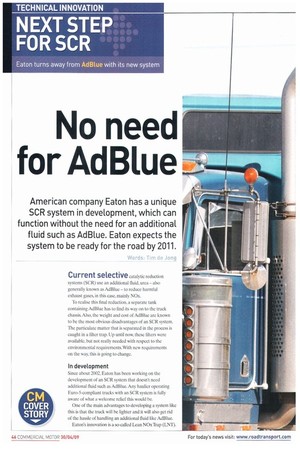No need for Ad Blue
Page 46

Page 47

If you've noticed an error in this article please click here to report it so we can fix it.
American company Eaton has a unique SCR system in development, which can function without the need for an additional fluid such as AdBlue. Eaton expects the system to be ready for the road by 2011.
Words: Tim de Jong Current seLective catalytic reduction systems (SCR) use an additional fluid. urea — also generally known as AdBlue — to reduce harmful exhaust gases, in this case. mainly NOx.
To realise this final reduction, a separate tank containing AdBlue has to find its way on to the truck chassis. Also, the weight and cost of AdBlue arc known to be the most obvious disadvantages of an SCR system. The particulate matter that is separated in the process is caught in a filter trap. Up until now, these filters were available, but not really needed with respect to the environmental requirements With new requirements on the way, this is going to change.
In development
Since about 2002. Eaton has been working on the development of an SCR system that doesn't need additional fluid such as AdBlue. Any haulier operating Euro-5-compliant trucks with an SCR system is fully aware of what a welcome relief this would be.
One of the main advantages to developing a system like this is that the truck will be lighter and it will also get rid of the hassle of handling an additional fluid like AdBlue.
Eaton's innovation is a so-called Lean NOx Trap (LNT).
This is the most vital of three catalysts in the overall exhaust system that has been designed by the firm. The other two catalysts are tried and tested. In the first, injected fuel is split into hydrogen and carbon monoxide, This fuel is then injected to regenerate the particle filter, which blocks the air stream from time to time because of the trapped particles.
The heat from the fuel regenerator is used to clean the filter.
Eaton's new catalyst, the LNT slots in between the other two and continuously collects NOx and sulphur compounds that are released.
When the LNT reaches its NOx storage capacity, a controlled fuel dose is introduced into the exhaust upstream of the reformer.
Reformate exiting the reformer reacts with the stored NOx in the LNT, and is released as environmentally harmless nitrogen. Simultaneously, the LNT creates ammonia, which is used by the downstream SCR catalyst for further NOx reduction.
How it works
However, the most important breakthrough from Eaton is why additional AdBlue is no longer needed. -Nu The sulphur compounds collected on the LNT diminish its effectiveness. This requires desulfation — vital to remove the sulphur and restore the LNT's effectiveness.
The target market
One of the issues with AdBlue is that it is known to freeze at -11°C, which means the success of the chemistry involved often depends on the outside temperature.
According to Tom Stover, the vice-president, technology for Eaton's truck business, the system will be marketed through engineand truck-makers. He adds: "Possible customers are operating the system now. The trucks are being tested in the north of Minnesota in freezing temperatures as well as in the heat of Death Valley."
Eaton was supposed to have this system production ready before the implementation of EPA 10. However, it seems that it is going to be a year late at least.
Delays aside, Stover sees the segment of construction vehicles, as well as American Class 8 trucks. as the main target markets. Since these Class 8 trucks increasingly share A If Eaton's new system their engine technology with their European counterparts, is adopted in Europe, this AdBlue-free SCR system could erase one of the most Ad Blue tanks may be obvious disadvantages of the most widely used consigned to history environmental system in use today... •












































































































































